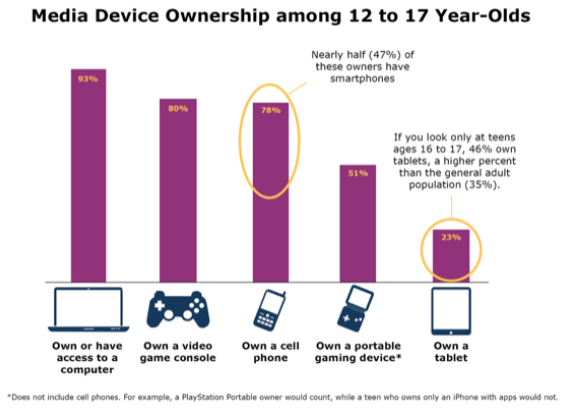I think that the biggest challenge of new media, specifically social media, going forward is the number of hours spent on those sites, and the effects on kids social relationships and health. Generation Like gave us a real look at how much social media and interaction with celebrities is prevalent in the lives of children today. A few of the kids mentioned being on their computers or devices for over five hours a day. They also mentioned feeling like they had a relationship with certain celebrities. While an increase in time spent on social media makes sense with all of the options now, this time kids spend online can have harmful effects to their well being.
Kelly Wallace, from CNN.com, reports, “on any given day, teens in the United States spend about nine hours using media for their enjoyment, according to the report by Common Sense Media.” That is more time then an average adult spends sleeping. All this time on spent using media, such as Instagram or Facebook, displaces other activities. In 2012 Pea et al. found a relationship between spending more time watching TV, on YouTube, and playing video games, and difficulty making and keeping friends and also having fewer friends. Spending all this time online takes away from real meaningful conversation. While some findings report that the Internet can help people make friends (Wolak et al., 2002), they are only online friends. In reality someone you only know online isn’t really a friend. They are not going to be there for you in a moment of crisis or when you want to get dinner and hangout. So is all this time spent making social relationships online really meaningful? My answer is no. New media needs to find a way to make those 9 hours spent online meaningful.

Another negative issue with all this time spent online is obesity. According to Vandelanotte, Sugiyama, Gardiner, & Owen’s study on the Associations of Leisure-Time Internet and Computer Use With Overweight and Obesity, Physical Activity and Sedentary Behaviors: Cross-Sectional Study, “the main finding of this study is that leisure-time Internet and computer use is strongly related to being overweight or obese, whereas it is largely independent of leisure-time physical activity.” This is alarming and a major cause for concern. In a country already plagued with obesity issues media is only worsening that effect. This is a major challenge new media is going to have to overcome. Currently interacting with media usually involves sitting in front of a screen and passively watching or pressing buttons. This is a sedentary behavior, you are not moving. In order to be healthy one must partake in physical activity. Besides inventions like the WiiFit and workout TV almost all media is considered sedentary. Children today are growing up spending hours leisurely using the internet, which could have major impacts on their health.
Considering the rise in technology use in today’s world new media is going to need to find a way to combat these negative, harmful effects with a new approach to creating content. I think this will be a big challenge for new media to have to realize and overcome.
References
Koughan, F., & Rushkoff, D. (Writers). (2014, February 18). Generation Like [Television series episode]. In Frontline. PBS.
Pea, R., Nass, C., Meheula, L., Rance, M., Kumar, A., Bamford, H., . . . Zhou, M. (2012). Media use, face-to-face communication, media multitasking, and social well-being among 8- to 12-year-old girls. Developmental Psychology, 48(2), 327-336. doi:10.1037/a0027030
Vandelanotte, C., Sugiyama, T., Gardiner, P., & Owen, N. (2009). Associations of Leisure-Time Internet and Computer Use With Overweight and Obesity, Physical Activity and Sedentary Behaviors: Cross-Sectional Study. Journal of Medical Internet Research, 11(3), e28. http://doi.org/10.2196/jmir.1084
Wallace, K. (2015, November 3). Teens spend 9 hours a day using media, report says. Retrieved April 21, 2016, from http://www.cnn.com/2015/11/03/health/teens-tweens-media-screen-use-report/
Wolak, J., Mitchell, K. J., Finkelhor, D. (2002). Close online relationships in a national sample of adolescents. Adolescence, 37, 441-455.








